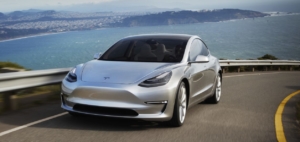“I think we will do a compact car in less than five years,” Elon Musk declared at the 2018 Tesla Shareholders Meeting. To date, it’s been an open question as to whom, if anyone, will disrupt the mass market compact segment, which moves almost 15 million units globally and more than 2 million in the US. Compact leaders Honda and Toyota sell an annual combined total of 1.7 million Civics and Corollas on a global basis, and roughly 675,000 in the US. No one has a compact EV in production, or on the horizon, with a prayer of making a dent in those numbers. The Nissan Leaf is a joke, with no charging solution for long distances and insufficient range.
Up until now, Tesla hasn’t even hinted at plans to sell a car for under $35,000. Even under the most optimistic scenarios in which Tesla ramps to 500,000 – 750,000 units each of its midsize Models X and Y, or 1 million to 1.5 million total, this would leave the $19,000 – $30,000 compact market mostly unaddressed. We can assume some potential buyers of compacts at the high end of that price spectrum will stretch their budgets to buy an entry-level, $35,000 Model 3. However, there are masses of working class consumers who can’t afford a $35K car, no matter what its benefits. Furthermore, a midsize car is too large for many people. The compact and subcompact sizes are popular for reasons beyond pricing, including the squeezed parking spaces and narrow garages found in dense urban environments.

A smaller version of the Model 3 would conquer the Compact world.
Now, it’s certainly possible that Tesla’s future compact will be priced at levels nearly identical to, or slightly below, the Model 3, placing it like a smaller BMW 2-series or an Audi A3 in terms of market position. However, I think this is unlikely. Tesla’s mission is to accelerate the world’s transition to sustainable energy. Tesla understands that someone has to sell a mass market compact EV. Otherwise, the transition will get stuck in third gear. Furthermore, the premium compact segment is smaller than a postage stamp, moving less than 100,000 units in the US annually.
At the Shareholders meeting, Musk revealed that Tesla is making rapid strides in reducing battery costs. This is the key to the kingdom. Furthermore, Musk stated that Tesla is planning two additional Gigafactories in the near term, in China and Europe, and eventually will grow to twelve Gigafactories. By the time Tesla introduces its compact car, it will have vastly more experience and economies of scale, plus a Supercharger network that blankets the globe.
All of these tells point toward Tesla selling a compact Model 2 (a shrunk-down Model 3) with a base price of $20K – $25K. If a budget-constrained consumer could buy a Tesla with 200 miles of range and access to a ubiquitous Supercharger network, why would they even consider a Civic or a Corolla? At $25K, it’s a grand slam. At $20K, it’s a board-clearing game over. This assumes no incentives or rebates.
A Model 2 at a $20 – $25K base price might entail selling it at cost. Musk won’t care if the base model is break-even, as there will be profits aplenty from higher spec Model 2s. Furthermore, Tesla will be rolling in Model 3, Y, Semi, and Pickup profits. It won’t need to make money on a new model, the way the company does today.
A further indication of where a Model 2 would be priced is found in the German German magazine WirtschaftsWoche’s report on a Model 3 teardown, that indicates a $28K cost based on a presumed 10,000 per week future run-rate. Musk validated that math as accurate. Imagine what it will cost per unit for Tesla to manufacture 28,000 per week of a Model 2, five years from now. Let’s assume Tesla sells 1.5 million Model 2s globally per year; roughly as many as the Model 3 and Y combined, or as many as the current Civic and Corolla combined. This is a conservative number, and would mean Tesla is only capturing 10% of the global compact market.
So, mark your calendars: in 2023 we’ll see the introduction of the Model 2, with a $20 – $25K base model. At that point, Honda and Toyota will be facing an existential crisis similar to the one that Model 3 is unleashing on BMW and Mercedes, as sales of their most popular vehicles disappear like dinosaur dust in the wind.